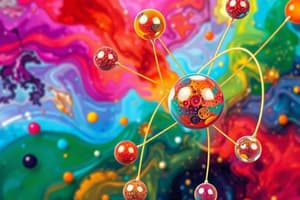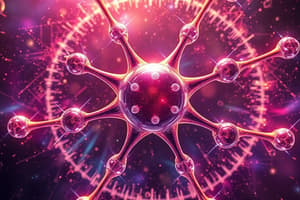Podcast
Questions and Answers
What is the main difference in the motion of particles between the three states of matter shown in Fig. 1.5?
What is the main difference in the motion of particles between the three states of matter shown in Fig. 1.5?
- The particles in the solid state have the most kinetic energy.
- The particles in the gas state have the most freedom of movement. (correct)
- The particles in the gas state have the least amount of space between them.
- The particles in the liquid state are more tightly packed than the solid state.
Which of the following substances has the highest density?
Which of the following substances has the highest density?
- Cotton
- Air
- Honey
- Iron (correct)
Why does a gas fill the entire container it is kept in?
Why does a gas fill the entire container it is kept in?
- Gases have high kinetic energy. (correct)
- Gases have high compressibility.
- Gases have low density.
- Gases have high fluidity.
Why is a wooden table considered a solid?
Why is a wooden table considered a solid?
Why does ice float on water?
Why does ice float on water?
What is the main reason we can easily move our hand through air but not through a solid block of wood?
What is the main reason we can easily move our hand through air but not through a solid block of wood?
What happens to the level of water in the beaker when salt is dissolved in it?
What happens to the level of water in the beaker when salt is dissolved in it?
What do the particles of salt do when they are dissolved in water?
What do the particles of salt do when they are dissolved in water?
In the activity with potassium permanganate, what does diluting the solution multiple times help demonstrate?
In the activity with potassium permanganate, what does diluting the solution multiple times help demonstrate?
What is a key idea behind putting an unlit incense stick in a corner of a class?
What is a key idea behind putting an unlit incense stick in a corner of a class?
What does the disappearance of salt/sugar granules in water during an experiment help demonstrate?
What does the disappearance of salt/sugar granules in water during an experiment help demonstrate?
How does the concept of dissolving salt in water support the idea that matter is made up of particles?
How does the concept of dissolving salt in water support the idea that matter is made up of particles?
What happens when camphor is heated slowly?
What happens when camphor is heated slowly?
What is the process called when a gas directly changes into a solid?
What is the process called when a gas directly changes into a solid?
Why is solid carbon dioxide (CO2) also known as dry ice?
Why is solid carbon dioxide (CO2) also known as dry ice?
What determines the state of a substance, whether it will be solid, liquid or gas?
What determines the state of a substance, whether it will be solid, liquid or gas?
What happens when a gas is compressed by applying pressure?
What happens when a gas is compressed by applying pressure?
What is the unit used to measure atmospheric pressure?
What is the unit used to measure atmospheric pressure?
Why can liquids take the shape of the container they are placed in?
Why can liquids take the shape of the container they are placed in?
What is the significance of dissolved oxygen and carbon dioxide in water for aquatic animals and plants?
What is the significance of dissolved oxygen and carbon dioxide in water for aquatic animals and plants?
Why does the rate of diffusion of liquids tend to be higher than that of solids?
Why does the rate of diffusion of liquids tend to be higher than that of solids?
Why do aquatic animals require dissolved oxygen in water for survival?
Why do aquatic animals require dissolved oxygen in water for survival?
In the gaseous state, why do particles have greater space between each other compared to the solid state?
In the gaseous state, why do particles have greater space between each other compared to the solid state?
What is the main reason behind a balloon seller being able to fill many balloons from a single cylinder of gas?
What is the main reason behind a balloon seller being able to fill many balloons from a single cylinder of gas?
What happens to the surroundings when a liquid evaporates from an open vessel?
What happens to the surroundings when a liquid evaporates from an open vessel?
Why do people sprinkle water on roofs or open ground after a hot sunny day?
Why do people sprinkle water on roofs or open ground after a hot sunny day?
Why does wearing cotton clothes in summer help in keeping the body cool?
Why does wearing cotton clothes in summer help in keeping the body cool?
What is the main reason for seeing water droplets on the outer surface of a glass containing ice-cold water?
What is the main reason for seeing water droplets on the outer surface of a glass containing ice-cold water?
Why does pouring acetone (nail polish remover) on your palm make your palm feel cool?
Why does pouring acetone (nail polish remover) on your palm make your palm feel cool?
Why do particles at the surface of a liquid gain energy from the surroundings during evaporation?
Why do particles at the surface of a liquid gain energy from the surroundings during evaporation?
Flashcards are hidden until you start studying
Study Notes
Activity 1.1: Dissolving Salt in Water
- Dissolving salt in water does not change the water level, but the salt particles spread throughout the water, filling the spaces between water particles.
- This activity illustrates the idea that matter is made up of particles.
Properties of Particles
- Particles of matter are continuously moving.
- The motion of particles can be seen and compared in the three states of matter: solid, liquid, and gas.
Effect of Change of Temperature
- Density is the mass per unit volume of a substance.
- Density = mass/volume.
- The order of increasing density is: air, exhaust from chimneys, honey, water, chalk, cotton, and iron.
- Changes in temperature can affect the state of a substance, whether it will be solid, liquid, or gas.
Characteristics of States of Matter
- Solids: rigid, fixed shape, and volume.
- Liquids: fluid, fixed volume, but take the shape of the container.
- Gases: fill the container completely, exert pressure on the walls of the container, and have no fixed shape or volume.
Activity 1.12: Melting of Ice
- Ice floats on water because its density is lower than that of liquid water.
- When ice is heated, it melts and becomes liquid water.
Can Matter Change its State?
- Matter can change its state from solid to liquid to gas or vice versa.
- Sublimation is the change of state from solid to gas without changing into liquid.
- Deposition is the change of state from gas to solid without changing into liquid.
- Applying pressure and reducing temperature can liquefy gases.
Effect of Change of Pressure
- The difference in various states of matter is due to the difference in distances between constituent particles.
- When pressure is applied, the distance between particles decreases, and the state of the substance can change.
- Solid carbon dioxide (CO2) is known as dry ice and changes directly into a gas when the pressure is decreased.
Activity 1.4: Diffusion of Solids and Liquids
- Solids, liquids, and gases can diffuse into liquids.
- The rate of diffusion of liquids is higher than that of solids.
- The presence of dissolved oxygen in water is essential for the survival of aquatic animals and plants.
The Gaseous State
- Gases can fill a container completely and exert pressure on the walls of the container.
- The particles of a gas are much farther apart than those of a solid or liquid.
Activity 1.11: Evaporation
- Evaporation occurs when the particles of a liquid absorb energy from the surroundings and change into vapor.
- The rate of evaporation depends on temperature, surface area, and wind velocity.
- Evaporation causes cooling due to the absorption of energy from the surroundings.
Cooling Due to Evaporation
- Examples of cooling due to evaporation include: sprinkling water on a hot surface, wearing cotton clothes in summer, and evaporation of sweat from the body.
- Evaporation is an essential mechanism for the body to regulate its temperature.
Studying That Suits You
Use AI to generate personalized quizzes and flashcards to suit your learning preferences.




